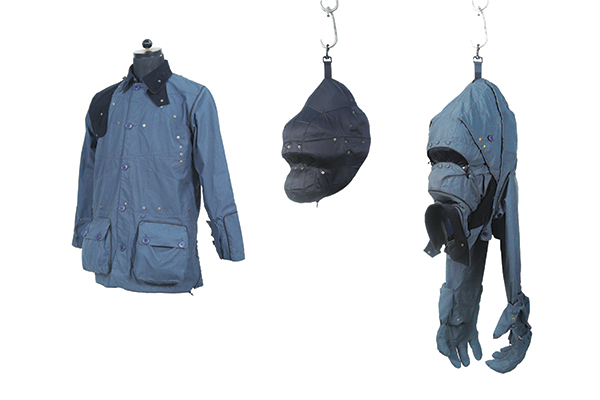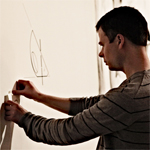Dyslexic Design is an exhibition curated by designer Jim Rokos FRSA which explores the connection between dyslexia and the creative industries. The project, in support of the British Dyslexia Association, will celebrate dyslexic designers’ work during the London Design Festival. Jim, a former winner of the RSA Student Design Awards, is passionate about challenging perceptions of dyslexia by accentuating its positive effects and close association with design.

Hello, I’m Jim. Writing for the RSA blog is a big deal for me.
This is because I was the kid who was regularly kept behind after school to finish copying from the backboard. All the others in class would have long gone home whilst my teacher, and my mother who had come to collect me, would be making grown up small talk, whilst I finished the writing.
A couple of schools later I discovered that I was dyslexic.
Schools are a disaster for a dyslexic’s self-confidence. If someone wanted to create a model for systematically removing a dyslexic child’s self-confidence, then the current education system would achieve this well. Imagine giving someone a task that they cannot resolve, testing them on it and measuring the result. Then, comparing their results with all those around them who had performed considerably better, and repeating this every day of their young, formative years.
After this long and intensive training, I still struggle with self-confidence, even though I know that, as an idea, there is nothing wrong with me.
Education tries to make us all the same, but we are all different, so this approach doesn't work. Education treats dyslexia as a disability but it is our education system that is disabling dyslexics. Because dyslexia is invisible, it is taking us a really long time to solve the education problem.
Dyslexia is not a disability – it is an alternative brain structure, which creates a processing difference and so brings alternative aptitudes. One could equally label someone as disabled if they were not good at visual thinking, but we would not do that, because most people are not strong visual thinkers. It would not make sense to regard a majority of people as disabled. Diversity is advantageous in groups of people.
Dyslexia is a natural part of neurodiversity. But education is not diverse. All our bodies are different, and society can manage this because bodies are visible. Imagine if athletics training was the same as the way we teach. We would be expecting the marathon runners to perform well, even though we train them as weight lifters. In turn, we would be labelling our weightlifters as disabled because they need extra time to complete a marathon.
The problem is that our education system only works for the majority of brain types. We need a diverse education system to match the population.
School-work was very difficult, but I have grown to appreciate that my dyslexia is also a gift which gives me a distinctive perspective on the world. Now that I am an industrial designer with my own brand of homeware, I believe that I am able to design the way I do because of my dyslexia and not despite it. I also feel that other dyslexic designers have idiosyncratic styles because of their dyslexia.
This month I am curating an exhibition: Dyslexic Design. It brings together 12 leading designers’ works, with the aim of collectively showing that dyslexia comes with gifts. Disciplines include fashion, illustration, fine art and design. One of the exhibitors is our own RSA Royal Designer for Industry, Terence Woodgate. Our works on show are playful and illustrate the strengths dyslexia brings: lateral, visual and three-dimensional thinking.
The solutions to problems in the works are surprising. Dyslexics easily turn things upside-down and inside-out in their minds. Rohan Chhabra's Hunter Jacket - Gorilla demonstrates incredible, three-dimensional thinking. The jacket unbuttons and unzips, and these parts can then be re-assembled into the form of a gorilla (think Transformer Robot, in fabric). Eighty metres of wood is twisted up to form Tom Raffield's Pendant No. 1 - a 65cm diameter lampshade. Playful environment designer, Ab Rogers, is designing our exhibition space which will hold these works together.

Rohan Chhabra's Hunter Jacket
I hope that dyslexics who have yet to discover the positive abilities that their dyslexia brings will have their minds opened to the possibilities that their dyslexia will offer them. I also hope that people at the exhibition will leave feeling inspired and that they have visited another world. When they step back into their everyday lives perhaps they will see it with different eyes. Perhaps their minds will make it kaleidoscopic and full of ideas. I would like dyslexics to know that what might seem like knots, the lopsided and dangling parts in their brains, are actually useful. They can ‘see’ things overhead as well as inside.
It is my dream that in the future both the education system and the way that we present information will be designed so that a dyslexic mind is not disadvantaged. It would be wonderful to enhance our collective value of this, so that schools and workplaces can learn how to nurture and capitalise on all that this alternative brain wiring has to offer.
Jim Rokos FRSA is raising funds for the exhibition Dyslexic Design which opens on 22 – 25 September at design junction during the London Design Festival.
Dyslexic Design
Dyslexic House
No. H9 (Far East side)
designjunction
Granary Square
King's Cross
London
N1C 4AA
Thursday 22 September 11.00 – 20.00hrs
Friday 23 September 11.00 – 19.00hrs
Saturday 24 September 11.00 – 18.00hrs
Sunday 25 September 11.00 – 17.00hrs
Dyslexic Design Discussion
Saturday 24th September, 5pm. (Venue tba.)
How to be Creative & Successful when you are Dyslexic . . .
Chair: Grant Gibson - design & architecture writer.
Panel: Tom Raffield - steam bent lighting & furniture, Margaret Rooke - writer, Kristjana S Williams - fine art, Terence Woodgate RDI - industrial design.
Media partner: Design Week.

Join the discussion
Comments
Please login to post a comment or reply
Don't have an account? Click here to register.
Completely agree. I once read all the list of things dyslexics are good and realised I could do all of them - I just had thought it was normal not a gift before that. I can sort though different items, find patterns, link up many different aspects much more effectively that most poeple and this is why I am good at what I do. i can go from A to E quickily whilst most poeple are going A to B to C to D ....